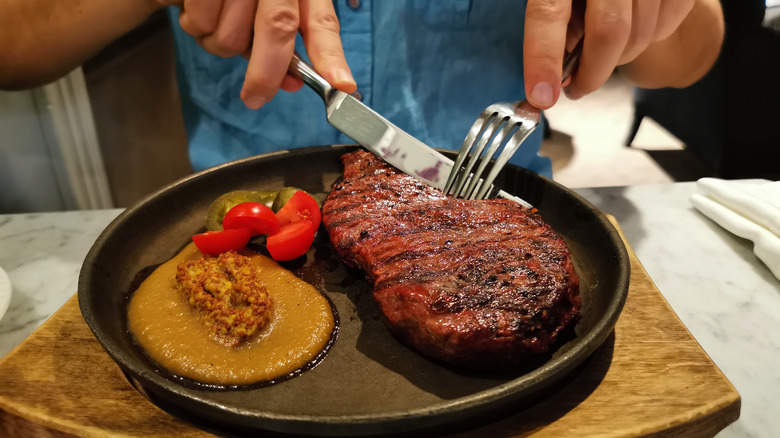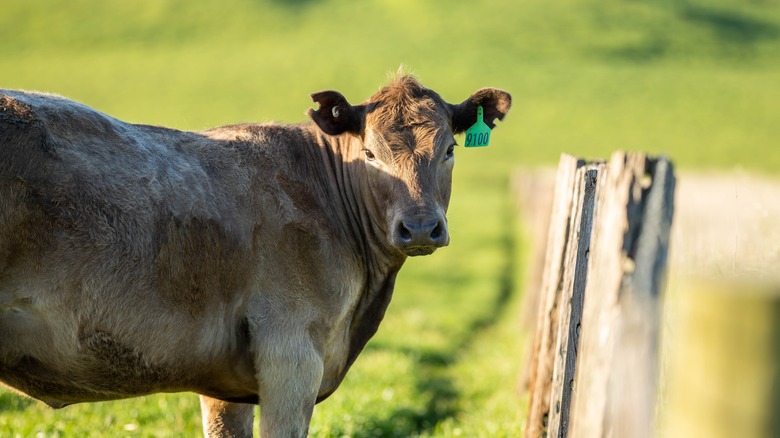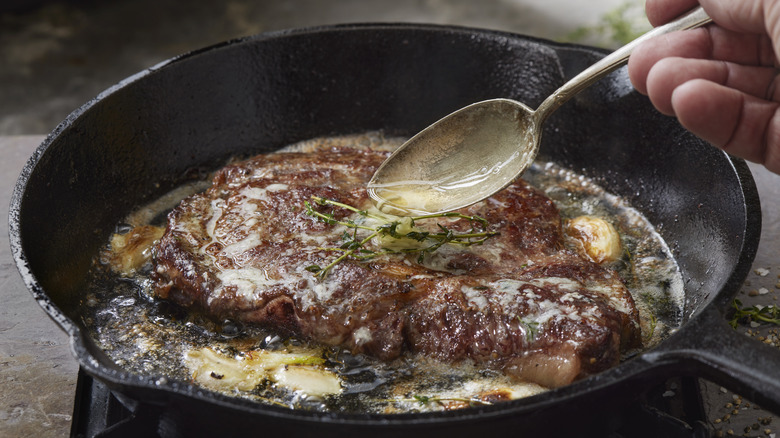Science Says This Is The Healthiest Steak You Can Eat (And It Has An Unexpected Benefit)
Food science has grown to such an extent that we can walk into a restaurant, order a steak, ask about its origins from the staff, and proceed to google its many nutritional benefits and downsides. Never before did we have more information at our fingertips. With health professionals telling us that "we are what we eat," this kind of information can be useful.
Into this landscape, comes the debate of whether steak is bad for you. It doesn't help that the saturated fat content in red meat has been associated with a number of risks, including heart disease. But red meat can offer a lot of nutritional benefits too, not the least of which is its rich protein content. One 250-gram steak contains as much as 62.2 grams of the macronutrient, per the U.S. Department of Agriculture. And that's not all. The protein from beef and other meat sources is a complete protein, which means it contains all of the nine amino acids your body needs. Additionally, beef has a good amount of vitamin B12, niacin, selenium, iron, and zinc.
There are ways to make sure you're eating the healthiest kind of steak. While looking for the leanest type of meat is one good tip, there's another thing to watch out for — choosing grass-fed beef instead of the grain-fed kind. Considered to be leaner and of higher quality, especially by health-conscious folk, grass-fed beef contains a higher amount of omega-3 fatty acids.
Grass-fed beef and omega-3 fatty acids: The connection
To be clear, all cattle are fed grass at first. It is what happens after the first 7-9 months of their existence that changes things. It is estimated that around 80% of cows in the U.S. are eventually moved into what is known as concentrated animal feeding operations, or CAFOs. At these feedlots, the cattle's main food source becomes grain, more particularly soy- or corn-based food. This is done for a few different reasons. One is to free up land space. Grain is also cheaper and easier to grow than grass. Another reason is that grain fattens up the cattle at a faster pace. Cows that feed primarily on grass don't grow — muscle- and meat-wise — at the same rate as grain-fed cattle do. One reason is that grain contains more energy.
This change from their feeding natural habitat, however, alters the molecular and chemical makeup of the meat, explained nutritionist Peter Osborne. "Most of your grains are extremely high in omega-6 fatty acids." Feeding cattle a primarily omega-6 fatty acid-rich diet changes the fatty acid composition of the meat, per the expert. "It drives it up to a very high level of omega-6 and a very low level of omega-3," shared Osborne.
Grass-fed beef (and therefore, steak), on the other hand, contains up to five times more omega-3 fatty acids. Omega-3 fatty acids have a lot of health benefits, including combating depression and anxiety; boosting eye, bone, joint, and brain health; lowering inflammation; and reducing symptoms of metabolic syndrome.
Other differences between grass-fed and grain-fed beef
Grass-fed beef may also contain less monounsaturated fat and more conjugated linoleic acid, or CLA. The latter has anti-carcinogenic and anti-hypertensive properties. CLA is also believed to combat obesity and diabetes. Grain-fed beef has a higher percentage of fat overall, and therefore more calories.
Proponents of grass-fed beef hold the opinion that this form of cattle rearing is more humane for the animal. Allowing the cows to roam freely in pastures to feed on grass as opposed to restricting them to smaller and stressful environments like CAFOs could have an effect on how the meat turns out. It doesn't help that cattle that are fed grain are also exposed to growth hormones in an effort to make them grow faster.
Does this mean you have to go looking for grass-fed beef options every time you want to enjoy a steak? Not necessarily. Some people might actually prefer the fattier grain-fed version, while others enjoy the tougher and darker texture of the grass-fed variety. There are also tips to make your steak healthier, no matter which kind you buy. As for the omega-3 fatty acid content, while organic beef can be a good addition to your dinner table, it is still not the best source of this healthy fat. "A standard serving of grass-fed top sirloin beef has about 65 mg of omega-3 fats ... There is no 'official' recommended intake level for omega-3 fatty acids, but the Institute of Medicine noted that healthy adults take in 1,100 (women) and 1,600 (men) per day," shared internist, Dr. Keith Roach (via The Detroit News).


